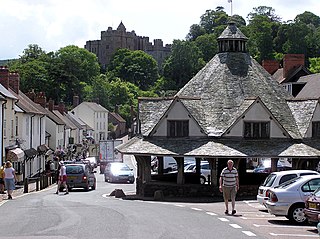
Dunster is a village and civil parish in Somerset, England, within the north-eastern boundary of Exmoor National Park. It lies on the Bristol Channel 2.5 miles (4 km) southeast of Minehead and 20 miles (32 km) northwest of Taunton. At the 2011 Census, it had a population of 817.

Woodspring Priory is a former Augustinian priory. It is near the scenic limestone promontory of Sand Point and Middle Hope, owned by the National Trust, beside the Severn Estuary about 3 miles (5 km) north-east of Weston-super-Mare, within the English unitary authority of North Somerset. Many of the buildings are Grade I listed, and the whole site is scheduled as an ancient monument.

Ashleworth is a village and civil parish in the Tewkesbury district of Gloucestershire, England, with a population of 614, about six miles north of Gloucester. It has a riverside pub, the Boat Inn. The oldest part of the village is Ashleworth Quay, on a flood plain on the west bank of the River Severn.

Great Coxwell Barn is a Medieval tithe barn at Great Coxwell, Oxfordshire, England. It is on the northern edge of the village of Great Coxwell, which is about 9 miles (14 km) northeast of Swindon in neighbouring Wiltshire.

Paston Great Barn is a medieval barn near Paston Hall on the southeast edge of the village of Paston in northeast Norfolk, owned by the North Norfolk Historic Buildings Trust. Dating from 1581, the building has a long association with the Paston family. A scheduled monument and a grade II* listed building, the barn is the centre of a 0.95 hectares biological Site of Special Scientific Interest, a National Nature Reserve and a Special Area of Conservation. It is in the Norfolk Coast Area of Outstanding Natural Beauty.
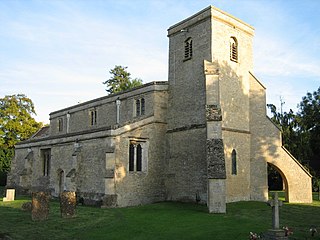
Launton is a village and civil parish on the eastern outskirts of Bicester, Oxfordshire, England. The 2011 Census recorded the parish's population as 1,204.
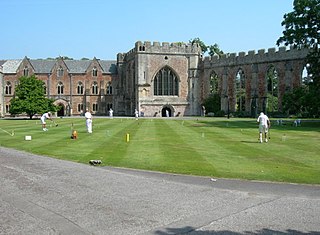
The Bishop's Palace is the residence of the bishop of Bath and Wells in Wells, Somerset, England. The palace is adjacent to Wells Cathedral and has been the residence of the bishops since the early thirteenth century. It has been designated a grade I listed building.

West Pennard Court Barn is a late 14th or early 15th century tithe barn which was built for Glastonbury Abbey. The Grade I listed building is between West Pennard and West Bradley in the English county of Somerset.

Stoke sub Hamdon Priory is a complex of buildings and ruins which initially formed a 14th-century college for the chantry chapel of St Nicholas, and later was the site of a farm in Stoke-sub-Hamdon, Somerset, England. The only building remaining from the college is a great hall and attached dwelling, dating from the late 15th century. The hall is designated by English Heritage as a Grade I listed building, while the outbuildings and gateway are Grade II listed. The whole site has been scheduled as an ancient monument. A number of the farm buildings are in poor condition, and have been added to the Heritage at Risk Register.
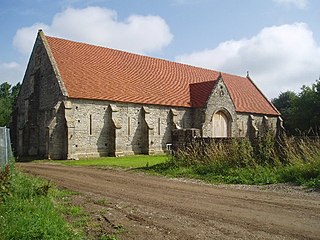
The Tithe Barn at Cumhill Farm in Pilton, Somerset, England, was built in the 14th century as a tithe barn to hold produce for Glastonbury Abbey. It is a Grade I listed building and Scheduled Ancient Monument.

The Bishop's Barn in Silver Street, Wells, Somerset, England, was built as a tithe barn in the 15th century. It has been designated as a Grade I listed building, and scheduled as an ancient monument.

The Tithe Barn at Manor Farm in Doulting, Somerset, England, was built in the 15th century, and has been designated as a Grade I listed building, and scheduled as an ancient monument.

Great Haseley is a village and civil parish in South Oxfordshire, England. The village is about 4.5 miles (7 km) southwest of Thame. The parish includes the hamlets of Latchford, Little Haseley and North Weston and the house, chapel and park of Rycote. The parish stretches 6 miles (10 km) along a northeast — southwest axis, bounded by the River Thame in the north, Haseley Brook in the south and partly by a boundary hedge with Little Milton parish in the west. The 2011 Census recorded a parish population of 511.
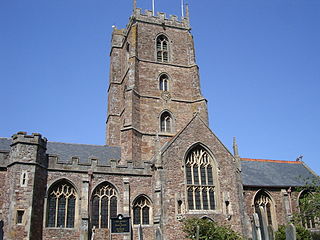
Dunster Priory was established as a Benedictine monastery around 1100 in Dunster, Somerset, England.

St Andrew's Church is a redundant Anglican church at the south end of the village of East Heslerton, North Yorkshire, England. It is recorded in the National Heritage List for England as a designated Grade I listed building and is under the care of the Churches Conservation Trust.

St Botolph's Church is a redundant Anglican church near the village of Skidbrooke, Lincolnshire, England. It is recorded in the National Heritage List for England as a designated Grade I listed building, and is under the care of the Churches Conservation Trust. It stands in an isolated position in the Lincolnshire marshlands, about 7 miles (11 km) northeast of Louth, and to the west of the A1031 road.
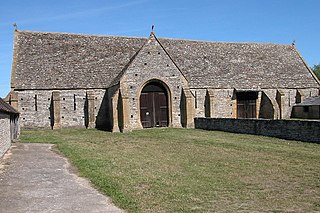
Middle Littleton Tythe Barn, also known as Middle Littleton Tithe Barn, is a grade I listed 13th or 14th-century tithe barn in the village of Middle Littleton, near Evesham in Worcestershire. It is one of the largest and most notable tithe barns in England. The barn is constructed of a mixture of Blue Lias and Cotswold stones, with a stone tile roof. It was originally built for Evesham Abbey, which was the third largest abbey in England. It is now owned and operated by the National Trust.

Ashleworth Court is a grade I listed house close to the River Severn in Ashleworth, Gloucestershire, England.
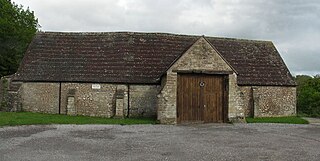
Mells Village Hall in Mells, Somerset, England was built in the 14th century as a tithe barn and now serves as the village hall. It is a Grade II* listed building.

The Tithe Barn, Sturry, Kent, England is a barn dating from the early 16th century. The barn was built as the tithe barn for the grange of St Augustine's Abbey, Canterbury. At the Dissolution of the monasteries, the grange came into the ownership of Thomas Smythe who converted some of the buildings into a country house, Sturry Court. The barn continued in use for agricultural storage. In the early 20th century, Sturry Court was the country home of Alfred Milner who renamed it Milner Court. On his death in 1925, his widow, Violet, gifted the estate to The King's School, Canterbury which operated a preparatory school on the site. The school was opened by Rudyard Kipling, a friend of the Milners, in 1929. The site is now the Junior School for The King's School and the tithe barn has been restored and repurposed as a performing arts centre. "Sturry's most memorable building", the tithe barn is a Grade I listed structure.





















